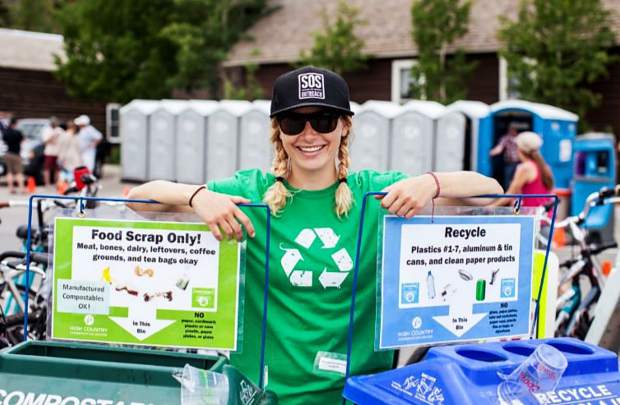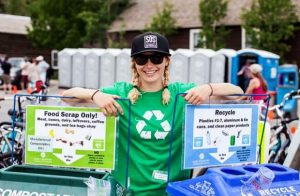Ask Eartha: What are some sustainable swaps for the laundry room?
Ask Eartha

Courtesy photo
Dear Eartha, I adopted some of your tips for making sustainable swaps, and now I’m feeling pretty eco-minded in the kitchen and bathroom. I’m ready to tackle another space. What suggestions do you have for the laundry room?
I like your step-by-step method. Taking it room by room and trying out the swaps that work for you can make changes approachable and lasting. Lucky for you — I’ve got a load of tips to keep you feeling fresh and free of plastics in the laundry room.
Eco-friendly detergents
Due to consumer demand for more natural detergent options, there is a dizzying array of “eco-friendly” detergents on the market available as liquids, powders, sheets, tablets and pods. To guide your decision-making, two things to consider are packaging and form.
While the typical No. 2 plastic laundry detergent bottle is recyclable both at drop-off recycling centers and in your curbside recycling bin (or shared recycling dumpster), you’re reliant on purchasing ever more plastic containers to keep your clothes clean. And to really put you through the spin cycle, these companies have got you paying a premium for a product made mostly of water. Instead, look for easily recyclable cardboard or paperboard packaging or infinitely recyclable aluminum or glass containers.
Laundry pods and sheet detergents can certainly help to cut down on packaging materials, but these product can still hamper our local environment in their own ways. For example, polyvinyl alcohol (PVA) found in detergent pods and sheets may not fully biodegrade and could contribute to microplastics in our waterways. To avoid these issues, you might opt for powder or tablet form of laundry detergent.
Microplastic catchers
Plastics aren’t just a concern in detergents — many of our clothes are also made of plastics. We all love a cozy fleece, but these sweaters are made of polyester which is a petroleum-derived product. When synthetic textiles are washed, they release microplastics into our watersheds, which can have harmful health effects on aquatic creatures and even find their way into humans. If you’re like me, you’re probably not willing to give up your Melly, but there are things we can do to mitigate the amount of microplastics our laundry releases. Products like Guppyfriend, a laundry bag that traps microfibers, and the Cora Ball, a spiny ball that prevents and collects microfibers in your wash, can both reduce microfibers released by around one-third. If you’re willing to invest, you can trap more microfibers for your buck by installing an external filter on your washing machine or purchasing a washing machine with a built-in filter, which can reduce microfiber release by up to 90%.
Wool dryer balls
Fleeces aren’t the only polyester product which ends up in your dryer — those lovely, lavender-scented dryer sheets are polyester-based, too. Ditch the single-use sheets for reusable wool dryer balls. Wool naturally absorbs moisture and the balls create more air circulation, reducing drying time by 25% and giving your clothes a nice fluff. If you miss the scent dryer sheets impart, add a few drops of your favorite essential oil on the wool balls before tossing them in the dryer.
Sustainable cycles
You can also make sustainable laundry swaps without spending a dime. The techniques we use to wash our clothes can also make a big impact. Wool dryer balls are a great tool but better yet, don’t dry your clothes at all. While our arid climate can be tough on our skin, it’s great for hang-drying clothes. Air drying on clothesline in the summer, or on a drying rack indoors, can save a household up to $2,100 and cut carbon dioxide emissions by over 3 tons over the lifetime of a dryer. Washing items on cold and only washing full loads are other sustainable hacks that lead to lower energy use and even reduce the amount of microfibers released.
With winter fast approaching, here’s another reason to get excited for a powder day. When you get back from the slopes, give snow washing a try. This time-tested technique has you clean your woolens by rubbing them in snow and letting them sit to naturally remove dirt and odors without using any detergent or energy not baaa-d!
All in all, petroleum products can be a real grease stain. I hope these tips help you to take laundry pollution to the cleaners.
Ask Eartha Steward is written by the staff at the High Country Conservation Center, a nonprofit dedicated to waste reduction and resource conservation. Submit questions to Eartha at info@highcountryconservation.org.


Support Local Journalism

Support Local Journalism
As a Summit Daily News reader, you make our work possible.
Summit Daily is embarking on a multiyear project to digitize its archives going back to 1989 and make them available to the public in partnership with the Colorado Historic Newspapers Collection. The full project is expected to cost about $165,000. All donations made in 2023 will go directly toward this project.
Every contribution, no matter the size, will make a difference.









